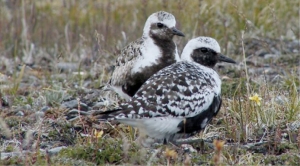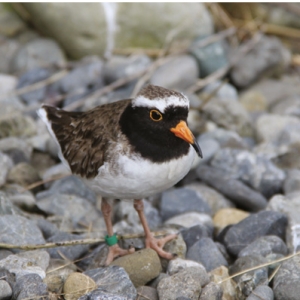Displaying items by tag: Plover
Pukaha releases shore plovers
Shore Plover - Tuturuatu
There was a slow start to the New Zealand shore plover/tuturuatu breeding season, most likely due to the severe winter. The Isaac Conservation and Wildlife Trust said three out of four NZ shore plover pairs are breeding. The fourth pair had not bred last spring, due to a grumpy male.
The first clutches had been lifted for artificial incubation, with eight chicks hatched. Two second clutches have been lifted, with another due shortly. The third clutches will be left with the pairs to rear.
Chicks will be directly transferred to offshore island holding aviaries, rather than to Trust aviaries, a new move to minimise dispersal, due to protect hatch site. Department of Conservation monitoring on Waikawa/Portland Island recently reported five pairs on eggs and one pair with a chick.
Photographed (left), a recently hatched critically endangered shore plover chick as it checks out its brooder box surrounds on the hunt for tasty mealworms. Shore plover are one of New Zealand’s very rarest of birds and are one of the world’s most threatened waders. They continue to be on the brink and captive breeding efforts are essential in creating and maintaining translocated offshore island populations.”
Sabrina Luecht
Breeding success continues at Mt Bruce Pukaha
Breeding success continues at Mt Bruce Pukaha
Shore Plover:
26 chicks were raised with some released at Waikawa and some at Motutapu. Four remain at Pukaha to continue with the breeding programme.
Pateke:
18 ducklings from the two breeding pairs at Pukaha. These were sent to the pre-release site, Peacock Springs near Christchurch, before they are released into the wild.
Whio:
2 male and 1 female ducklings hatched and reared by a pair at Pukaha have been sent to the pre-release site at Turangi. 13 ducklings were hatched from eggs collected from wild sites and of these 9 are male and 4 are females. They will remain at Mt Bruce Pukaha.
Plovers go to Russia for love
Two small migratory shorebirds - Grey Plovers from the Adelaide International Bird Sanctuary - made it once again all the way to the remote Wrangel Island off the coast of Russia near the Arctic Circle.
On their annual migration to breed the birds fly over 13000kms from Thompson Beach, north of Adelaide, including an incredible 7000km non-stop stretch from Adelaide to China.
“Who would have thought that a bird at Thompson Beach would, just a few months later, be roosting among polar bears and musk ox?” said Natural Resources Adelaide and Mt Lofty Ranges Manager of Coast and Marine, Tony Flaherty.
Mr Flaherty said the plovers were tagged with tiny solar-powered satellite trackers, to discover what parts of the Adelaide International Bird Sanctuary and Gulf St Vincent they use. Researchers also wanted to learn where they go and stop along their epic journey to the Arctic breeding grounds.
“Little was known about the migratory route of the plover, and knowing where these birds go really helps with conservation efforts to protect shorebirds,” Mr Flaherty said.
The tagged plovers left in March to fly along the East Asian-Australasian Flyway, taking distinctive routes to the northern hemisphere.
Mr Flaherty said uncovering this Grey Plover migration route can also help with international efforts to conserve their stop-over sites in Plover pair: Distinctive and tough birds. China and nesting sites in the Arctic.
“Disturbance and impacts to coasts across the birds’ migratory route all add up. What we do on our local beaches can also help these birds prepare for these incredible journeys.”
Researchers were also surprised at how little the birds moved from Thompson Beach during the Australian Summer. Here they spent their time feeding on the rich tidal flats and roosting on the beaches and nearby salt marsh and lagoons.
During the warmer months, the Adelaide International Bird Sanctuary, located north of Adelaide, is home to approximately 27000 resident and migratory shorebirds. The area provides a safe haven for the shorebirds and a smorgasbord for feasting.
The research has been carried out by a partnership between Friends of Shorebirds SE, the Victorian Wader Study Group and the South Australian Department of Environment, Water, and Natural Resources, with funding support from the Adelaide and Mt Lofty Ranges Natural Resources Management Board Shorebird Project and the Australian Government-funded Samphire Coast Icon Project.
Shore Plover breeding success at Pukaha Mount Bruce
The mission to save more than one endangered bird species has been enriched by last year’s successful breeding programmes at Pukaha Mount Bruce.
The Shore Plover programme saw over 10 birds transported from Pukaha Mt Bruce National Wildlife Centre to Motutapu Island in the Hauraki Gulf and Waikawa Island off the Mahia peninsula (see photo).
The shore plover is in a perilous position with fewer than 200 left in the wild and a history of conservation efforts being hampered by rat infestations. Shore plover were first spotted by observers on Captain Cook’s second voyage to New Zealand.
The shore plover is the most endangered bird reared and cared for at the Pukaha centre. It is very susceptible to mammalian predators; even one rat can cause enormous damage.
Past Department of Conservation attempts to establish shore plover on Mana and Portland Islands were undone by what was thought to be a single rat in both cases.
The breeding and hatching of over 10 chicks at Pukaha had been a real triumph for the staff and wider conservation efforts.
In another success for the breeding programme, over 10 pateke (brown teal) were bred and hatched at the centre in the last breeding season.
The endangered ducks have a wild population of between 2000 and 2500 making them New Zealand’s most rare mainland waterfowl.
As well as great results in the Shore Plover and Pateke recovery programmes, the whio (Blue duck) also produced more than one clutch of ducklings.
Pukaha new free flight aviary that opened in May 2016 enabled the breeding pair of whio that call it home to lay eggs which were then artificially incubated and hand-reared. Those ducks were sent to Turangi where they spent time in a purpose-built environment to prepare them for release to the wild.
The second clutch of eggs is allowed to stay with the parents and be raised naturally. The theory is that by letting the parents raise them, the ducklings will be better parents when it is their time to breed.
Laura Hutchinson - Marketing & Communications.
Pukaha Mount Bruce
027 244 1221
www.Pukaha.org.nz



